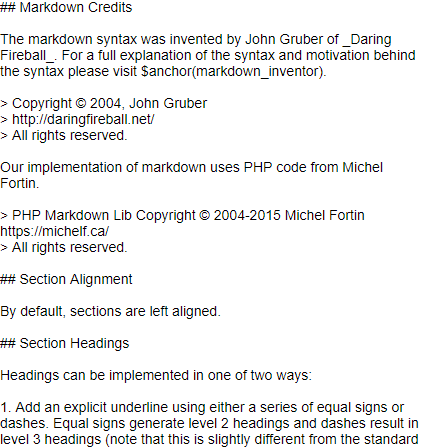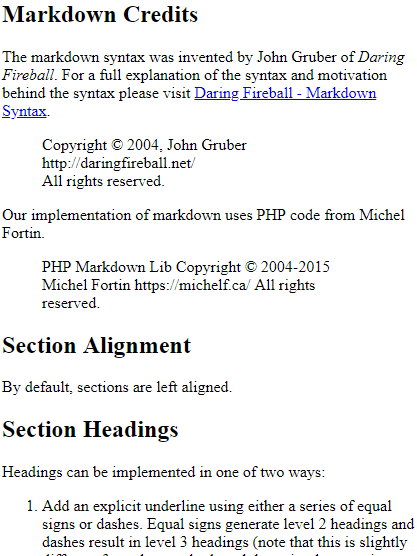Overview
The markdown model is intended to create simple web pages that do not require complex html or special styling. These pages can be free standing or they can be part of a blog or even a component of a larger page. Complex content can be intermingled with simple content either through the use of dollar functions or embedded html tags. Generally, embedded html should be kept to a minimum to avoid the risk of introducing html tags that are not well formed. Each page consists of a series of sections delimited by a blank line. The first few characters if each section are used to determine the section type and any special formatting to be applied to the sections.
Markdown Credits
The markdown syntax was invented by John Gruber of Daring Fireball. For a full explanation of the syntax and motivation behind the syntax please visit Daring Fireball - Markdown Syntax.
Copyright © 2004, John Gruber
http://daringfireball.net/
All rights reserved.
Our implementation of markdown uses PHP code from Michel Fortin.
PHP Markdown Lib Copyright © 2004-2015 Michel Fortin https://michelf.ca/ All rights reserved.
Section Alignment
By default, sections are left aligned.
Section Headings
Headings can be implemented in one of two ways:
- Add an explicit underline using either a series of equal signs or dashes. Equal signs generate level 2 headings and dashes result in level 3 headings (note that this is slightly different from the standard markdown implementation which uses equal signs to implement level 1 headings and dashes for level 2 headings. This is because level 1 headings are generated by other parameters associated with a page.
- Begin a line with a hash symbol (also called pound or number symbol) followed by a space then the heading text. The number of symbols determines the heading level.
Examples:
This is a level 2 heading since it is underlined with equal signs
===========================================
## This would be a level 2 heading (h2) since it starts with ##
### This would be an h3 heading
Emphasis
Underscores or asterisks are used to wrap words and phrases to be emphasized. The exact emphasis will be controlled by your site's styling with the default being the use of italics. For example, a sentence such as:
Mary had a _little lamb_
Would be shown as
Mary has a little lamb
If you want to actually show emphasis characters on the page, you must escape the character using a backslash character. For example to render *this* type \*this\*.
Unordered Lists
To create an unordered list, start a section with an asterisk followed by a space "* ". This will be followed by the first list item. Subsequent items in the list must also be prefixed by "* ".
Ordered Lists
Ordered list are similar to unordered lists except the first item must be prefixes by the digit 1. followed by a space "1. ". It is allowed but not necessary to sequentially number the subsequent items. These can all be prefixed by "1. " for example so that you don't have to renumber the items when inserting new elements into the list.
Horizontal Rule
Horizontal rules (lines) can be added to a page by entering three or more hyphens, asterisks, or underscores on a line by themselves..
Blockquotes
Text can be generated into a blockquote tag by prefixing the text with a greater than symbol (>).
Angle Bracket
To show angle brackets on the page enter them using the html symbols for angle brackets that is < for < and > for >.
HTML
You can enter any well-formatted html you wish.
Dollar Functions
Dollar functions can be intermingled with markdown text. Use dollar functions to add images, links, tables, etc.

